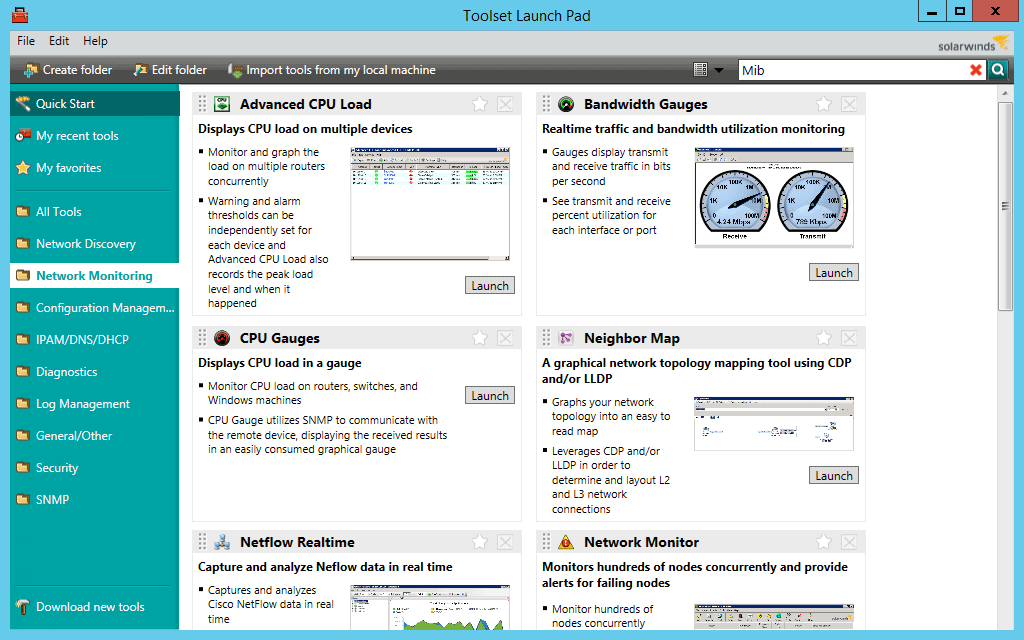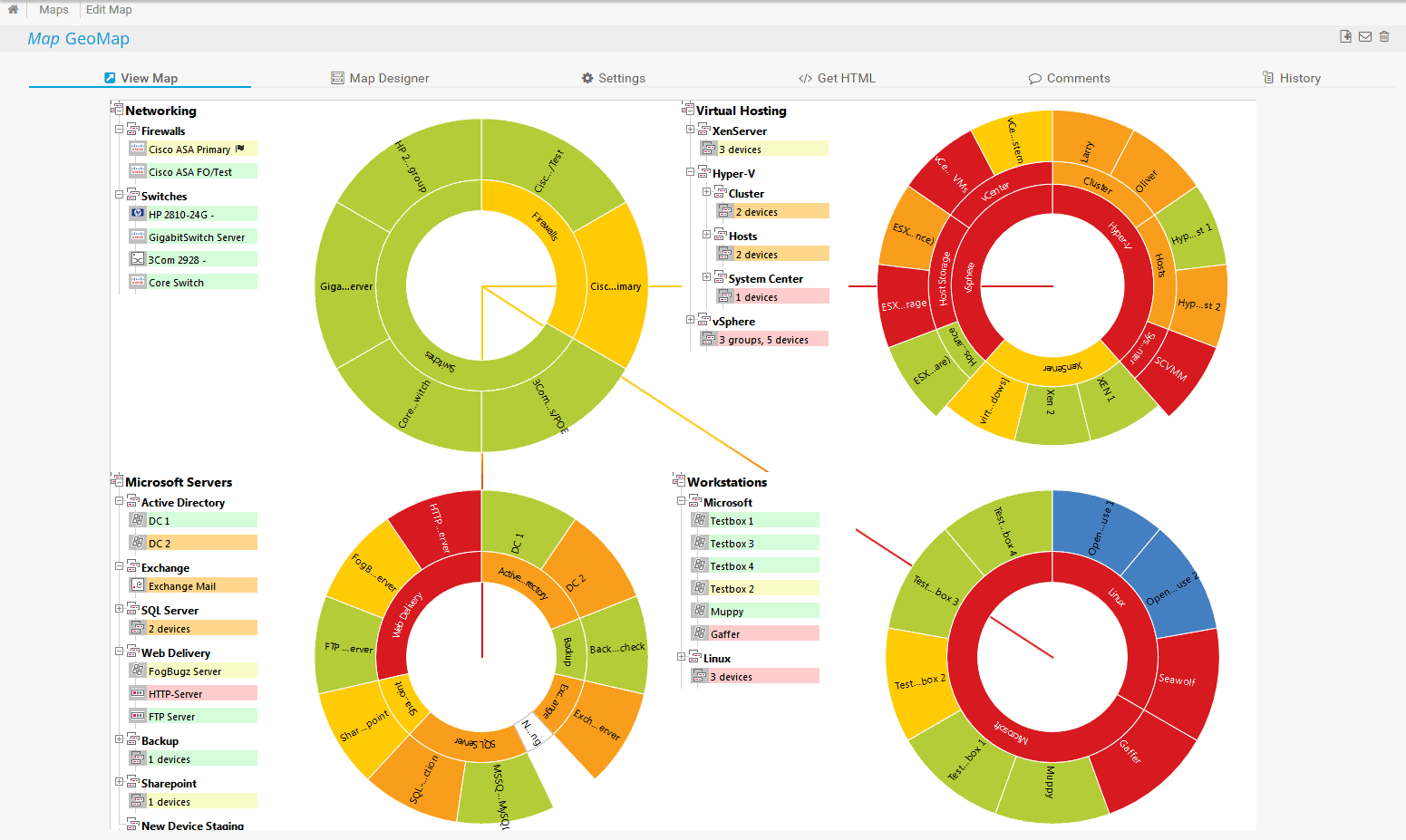Our funding comes from our readers, and we may earn a commission if you make a purchase through the links on our website.
The Best Cisco Network Magic Alternatives
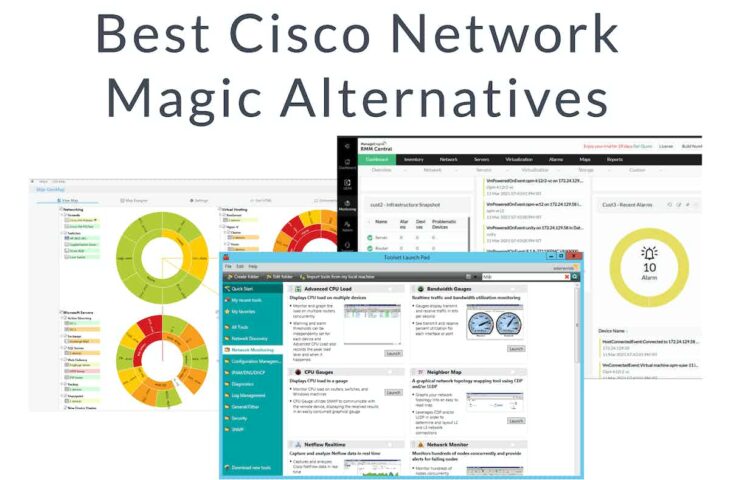
UPDATED: August 21, 2023
Since the depreciation of Network Magic by Cisco, many readers have been seeking similar solutions for remote PC management, patching, or hardware setup. This can be a difficult task since Network Magic had many unique features bundled into a single program.
In this article, we’ll dive into some of the best Cisco Network Magic alternatives that are still being supported today.
Here’s our list of the best Cisco Network Magic alternatives:
- SolarWinds Engineer’s Toolset – FREE TRIAL Features over 60 different networking and monitoring tools that are compatible with Windows Server. Download a 14-day free trial.
- Paessler PRTG Network Monitor – FREE TRIAL Extremely flexible platform with dozens of different monitors that cover infrastructure, software, application, and security monitoring. Start a 30-day free trial.
- Spiceworks IP Scanner A free cloud service that simply scans a new network and reports back the different devices it discovered.
- Atera A remote monitoring and inventory management system that uses network discovery to automatically pull new devices into its repository.
- Axence NetTools A free bundle of tools that can perform device discovery, as well as check open ports and identify services. It is ideal for smaller networks.
What features did Network Magic have?
Before Cisco stopped supporting the software, Network Magic was an incredibly flexible tool that offered a host of monitoring capabilities along with network discovery, and alerting features.
Network Magic supported:
- Auto device discovery
- Bandwidth usage monitor per PC
- Hardware and software identification for each PC
- Cross-platform communication with PC and macOS
- Basic network troubleshooting tools
- Customized alerts
- Desktop screenshot capture
- Internet access controls
Remote Management: Network Magic featured a host of remote management tools which allowed you to manage files and data and even share them to remote PCs. This also allowed you access to a remote machine's file structure, which proved useful for troubleshooting and fixing simple problems like replacing a broken shortcut on a desktop.
Troubleshooting: The troubleshooting tools included in Network Magic were intuitive and covered many different aspects of IT infrastructure. The platform could automatically fix network connectivity issues as well as give you a detailed insight into bandwidth usage, resource consumption, and network connectivity.
Many of these tools supported an easy Wizard format which walked you through troubleshooting step by step or simply performed the tasks automatically in the background. This made a tech’s job a lot simpler, but also helped non-technical users fix problems on their own.
Parental Controls: Content blocking could be established on a per PC basis, allowing you to restrict websites or content for your children. The program could also show you exactly how many times a certain site was accessed, giving you additional context into the user session.
Total internet connectivity and usage were also reported, which could help parents get an idea of the total screen time their child was using. Having the option to restrict internet access and browsing activity without impacting the local area network was an impressive feature at the time.
Topology Mapping: Another core feature with Network Magic was the ability to map out your local area network via an autodiscovery feature. This feature is now built into many different solutions and offers a map to view a live and accurate representation of your network. From a troubleshooting standpoint, this can help determine if a device is causing issues on the network, has the wrong network configuration, or doesn’t belong there in the first place.
Alerts & Reporting: In both the free and paid versions of Network Magic came with their own alert templates and reporting features. They could export and record the IP address, MAC address, and resource utilization of each device and export it in CSV format.
In the newer programs listed below, data exports are a common feature, and many of the enterprise and business-focused tools offer in-depth integrations that allow organizations to export data to other systems for archiving, or port information directly into a ticketing system to queue in the help desk.
Nowadays many tools with similar features are geared towards enterprise use, so if you’re simply a home user looking to monitor your family network a bit better, some of these tools might be more complicated than you’re used to.
With that in mind, we’ll include some smaller home-based network monitoring tools as well.
You’ll also notice that not every tool has the exact features included in Network Magic. That is because most software tools now focus solely on either network monitoring or parental controls.
The best Cisco Network Magic alternatives
1. SolarWinds Engineer’s Toolset – FREE TRIAL
SolarWinds Engineer’s Toolset is truly a network technician’s best friend. This bundle of over 60 networking and troubleshooting tools vastly outperforms the features found in both the paid and free versions of Network Magic.
IT professionals will appreciate the thoroughness of each tool, and can simply take this wherever they are without having to wonder if they forgot to download or include a testing tool on their own USB flash drive.
These tools can perform a range of tasks including MAC address discovery, SNMP sweeps, port scanning, configuration management, network discovery, and a host of hardware testing tools. For stress testing, there are numerous tools such as WAN Killer, which sends mock traffic over the network to test its ability to handle capacity before being put into production.
On the hardware side CPU Monitor, Memory Monitor, and Interface Monitor offer thorough testing for each component and the ability to monitor each piece of hardware overtime with full logging capabilities. Some other handy tools for techs include a subnet calculator, DHCP, DNS auditing tool, and DHCP scope monitor, which can help quickly identify under or overutilized IP ranges.
SolarWinds Engineer’s Toolset is at number one due to its vast number of helpful resources that are specifically geared towards IT professionals. With that said, even some tech-savvy home users who relied on Network Magic will be able to utilize these same tools with a little practice and research.
Pros:
- Easy to use, tools are self-explanatory and designed to get the job done quickly
- Includes a suite of other helpful tools, specifically designed for network administrators and on-site technicians
- Aids in device discovery and testing
- Can help verify DNS and DHCP functionality for different devices
- Can easily export or import results from previous scans
Cons:
- Would like to see a longer 30-day trial time
You can download the entire Engineer’s Toolset completely free through a 14-day free trial.
2. Paessler PRTG Network Monitor – FREE TRIAL
PRTG Network Monitor by Paessler is a staple among the IT community, and for good reason. PRTG isn’t just software, it’s an entire management platform that can be configured to monitor everything from SQL servers to PC endpoints, and everything in between.
This is achieved by PRTG’s flexible monitor agents, which all install simply but are customized to monitor that specific device. The sensor collects that data and then displays valuable information back to your centralized dashboard.
With that said, PRTG is geared towards medium to enterprise-level networks with many features that are designed to be able to scale as organizations experience growth. Small home networks could use PRTG, but will likely find it to be more complex than what they need.
On the other hand, IT professionals will enjoy the platform’s auto-discovery features and easy implementation across large networks. As the agent discovers new devices, technicians can view a real-time live map that populates devices as they enter and leave the network.
Virtually all communication is captured through SNMP monitoring alongside a packet sniffer that works live on the network to pull in data on a per-packet level. Privacy is maintained by reading only the headers of the packets.
The PRTG platform performs routine checks across the network and can alert when problems are detected, conditional rules are broken, or unusual activity is found. The alerting features are robust and have features built in to help reduce alert fatigue and remove duplicate or incessant notifications. For organizations using an on-premises help desk, alerts can be routed directly to your ticketing platform through one of many PRTG integrations.
Pros:
- Uses a combination of packet sniffing, WMI, and SNMP to scan IP addresses as well as measure device performance
- Fully customizable dashboard is great for both lone administrators as well as NOC teams
- Drag and drop editor makes it easy to build custom views and reports
- Supports a wide range of alert integrations such as SMS, email, and integrations into platforms like Slack
- Supports a freeware version
Cons:
- Is a very detailed platform with many features that require time to learn
PRTG is available as both a cloud service or on-premises solution and is free to use up to 100 sensors. Experience PRTG firsthand with a 30-day free trial.
3. Spiceworks IP Scanner
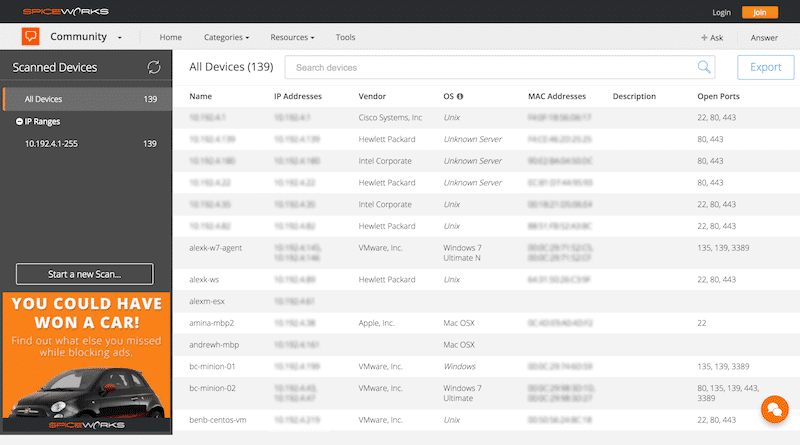
Spiceworks IP Scanner is a free lightweight tool that installs on your network and reports network conditions back to its cloud-based service. The simple install immediately begins to scan the network and find new devices and inventory them.
For Network Magic users who use the devices feature, you’ll be happy to know that Spiceworks IP Scanner works in a similar manner, and maintains that same ease of use that Network Magic once had.
Upon scanning, details such as IP address, MAC address, operating system, manufacturer, and hostname are all presented for each device that is detected. The tool also gives a brief overview of open ports on the devices, which is useful in understanding what services may be running on an endpoint.
Pros:
- Simple interface that scales well even on larger networks
- Provides a continuous live look into your network – recording address status
- Can run automated tests to alert sysadmin when devices come back online
- Highlights issues such as rogue DHCP servers and IP conflicts
- Consolidates IP, DHCP, and DNS information into a single view to help shorten troubleshooting time
Cons:
- The tool is designed for sysadmin, home users will likely not use all tools and features
All communications between the network discovery agent and the backend cloud are encrypted between you, and the Spiceworks server. A separate encryption key is provided that allows you to view your network information, ensuring that no one else can view that information.
These results can be exported for additional reporting or recordkeeping in CSV format. This tool is admittedly simple, however, for those who are keen on simply keeping track of devices on their network, this does an excellent job doing just that for small and medium-sized networks.
4. Atera
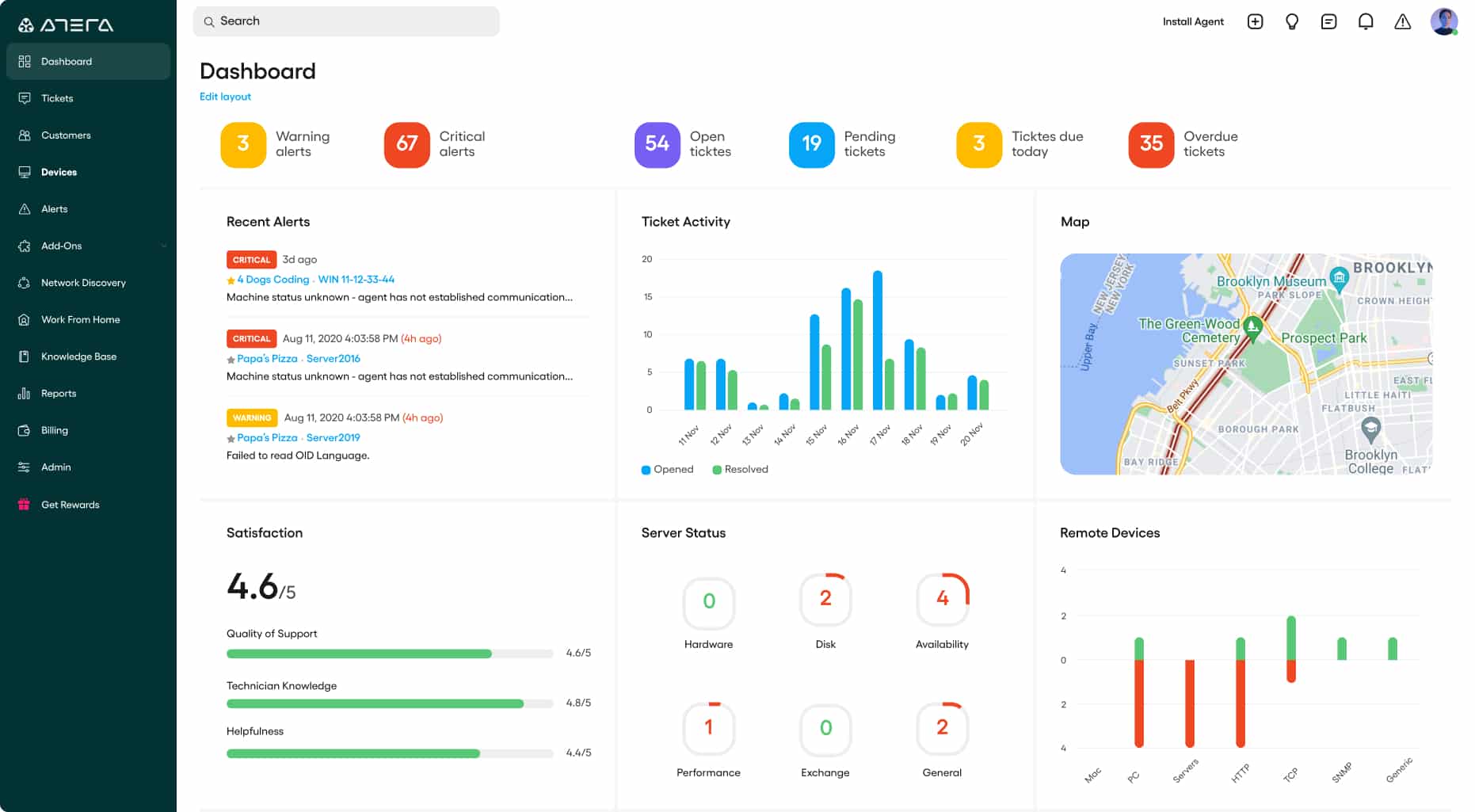
Atera is a networking monitoring and inventory management system that is designed to serve large enterprise networks, and service resellers such as MSPs. The cloud platform includes numerous tools for tech support that are geared towards simplifying the troubleshooting session and getting issues resolved quickly.
The remote monitoring and management tools included in Atera are considerably more detailed and robust than what was once in Network Magic. From network discovery to equipment and inventory management, all changes are reflected in real-time and show the most up-to-date version of online devices.
In addition, Atera can also act as a patch management tool and allow technicians to RDP or remote into managed servers and workstations. Each device’s network status, hardware resources, and operating system details are easily accessible for review. For MSPs that are looking to start up their business or run without setting up their own hosted infrastructure, Atera is a great option, and considerably better than Network Magic in many areas.
Pros:
- Lightweight cloud-based tool
- Built with MSPs in mind, and includes RMM and PSA tools built-in
- The framework is highly customizable, making Atera extremely flexible
- Can scale and support multiple databases in a multi-tenant environment
- Packaged pricing makes Atera accessible to any size business
Cons:
- Atera is MSP focused, smaller organizations may not use all multi-tenant featuresAtera is MSP focused, smaller organizations may not use all multi-tenant features
You can test out Atera free through a 30-day trial.
5. Axence NetTools
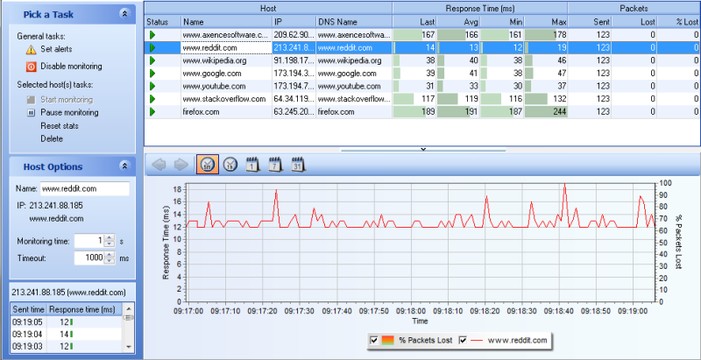
Axence NetTools is a packaged bundle of 10 different network tools that are completely free to use in a Windows environment. While the interface may seem a bit outdated, the power behind Axence free tools is on par with many similar Network Magic alternatives for smaller networks.
Just like Network Magic, Axence features a port scanner, device discovery, and service detection for new devices. Overall the tool can detect up to 50 different services, which makes it a great fit for smaller networks, but a bit restricted for larger enterprises.
Simple tools like a built-in netstat can run and detect a device's port status, as well as list the configuration information of each device. The built-in bandwidth tool can measure usage across the network as well as narrow down bandwidth hogs based on which device traffic is coming from.
The Netwatch feature is a form of continuous monitoring that consistently checks for packet loss, ICMP drops, and the DNS resolution of the targeted hostname. A traceroute function is also included, which closely mirrors the built-in Windows traceroute command. This measures the route and performance of the test packet along the way between you and the targeted machine.
Lastly, the Wintools feature scans the Windows Event Viewer logs and pulls relevant alerts to disk usage, memory errors, CPU performance, and page filing problems. This is a great timesaver, especially for help desk technicians who know just how slow and clunky a massive log repository can be in Event Viewer.
While some of these tools and tests can be performed manually through a command prompt, it’s a great alternative to save time and offers these troubleshooting techniques to a less technical audience.
Pros:
- Simple interface – provides built-in graphing
- Provides insights to 50 commonly used ports/services
- Completely free
Cons:
- Only available for Windows
- Not the best solution for larger networks
Related Post: Best Bandwidth Monitoring Software and Tools
Looking for Parental Controls?
One of the core features behind Network Magic was its ability to monitor PC activity simply, and restrict websites and internet traffic with relative ease. While the options listed above match or exceed the network monitoring capabilities of Network Magic, they lack the session-based monitoring you may be looking for.
Attempting to restrict certain sites manually, and decipher internet traffic manually is a futile task when it comes to controlling what your kids view online, and who they interact with. Using specialized parental control software makes this job easy, as they leverage artificial intelligence and known lists of “bad” sites that make blocking and restricting types of content simple.
Traditionally, network monitoring and user monitoring are separate activities that require separate software. If your focus is more centered around keeping your kids safe online, rather than monitoring the technical aspects of your network, the tools below can help.
Which Network Magic alternative is right for you?
As the years pass by, Network Magic just seemed to experience more problems, with no support or solution in sight. Switching to a tool that is supported and updated will not only help you monitor your network more efficiently but also ensure that you’re protected through security updates and patches.
If you were using Network Magic to monitor network infrastructure for a business, then switching to SolarWinds Engineer’s Toolset is your best bet. With over 60 tools tailored to virtually any technician’s needs, you’ll find that the bundle far exceeds what Network Magic alone could accomplish.
Enterprise-sized organizations will benefit greatly from the PRTG platform. Its ability to scale across thousands of endpoints and offer additional monitoring through the same dashboard simplifies the monitoring and device management process as a whole.
MSPs will find that Atera suits them the best. Its lightweight installer and cloud-based structure makes adding and managing new clients easy and offers additional inventory management and per client organizational features that were not available through Network Magic.
Lastly, families who just need to monitor their children's internet activity can use tools such as NetNanny or Qustodio to protect their kids from harmful content and restrict app usage or screen time.
Related Post: Cisco Commands Cheat Sheet
Network Magic FAQ
Can I still buy Network Magic?
No, Network Magic Pro is no longer available officially through Cisco.
Is using Cisco Network Magic illegal now?
No, using the tool is not illegal. However downloading the paid version for free from unofficial sources is illegal, and considered pirating.
Why was Cisco Network Magic discontinued?
The program was discounted when Cisco came out with their Smart Wi-Fi routers. These routers were able to automatically configure themselves and join the network. This new technology made Network Magic unnecessary.
Is Network Magic broken?
While it can still be used in some cases, many find that the tool does not work as well as it did in the past. This is because there is no longer a technical team supporting the product with updates, patches, or fixes. If you run into an issue with Network Magic, Cisco will not support fixing the problem anymore.

